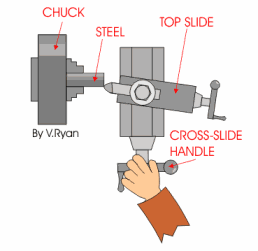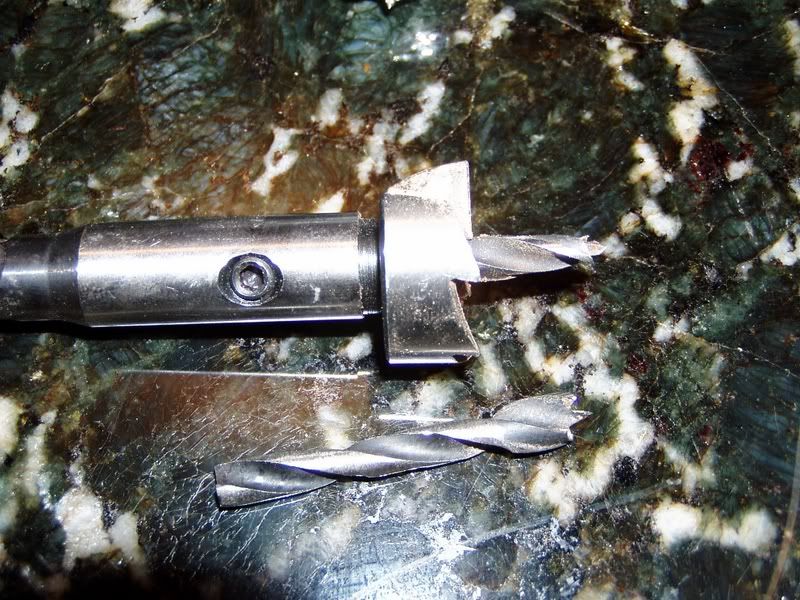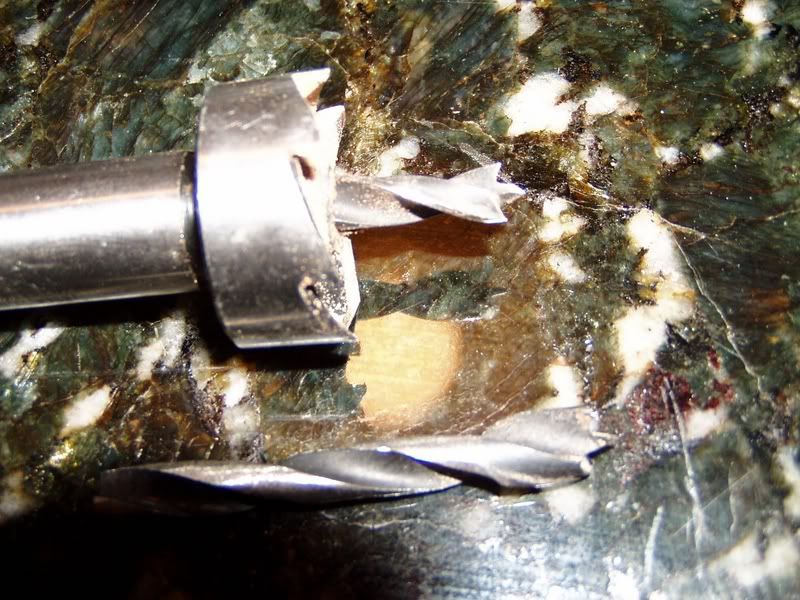taig micro lathe facing tool
-
timothy thorpe
- Posts: 167
- Joined: Mon Jun 11, 2007 6:20 am
- Location: new jersey
- Contact:
taig micro lathe facing tool
just pick-up the micro lathe on hobby lobbys site. here come the questions?? rad had been very helpful in helping me but i can't ask the man everything. i am trying to find the best facing tool for the lathe and also how to you chuck the stummel at 45 degrees to face it. thanks, tim
Re: taig micro lathe facing tool
The stummel is chucked up normally, but have your tool at a an angle to the face:timothy thorpe wrote:also how to you chuck the stummel at 45 degrees to face it. thanks, tim

(image borrowed from http://www.technologystudent.com/ )
-
timothy thorpe
- Posts: 167
- Joined: Mon Jun 11, 2007 6:20 am
- Location: new jersey
- Contact:
- KurtHuhn
- Site Admin
- Posts: 5326
- Joined: Thu Nov 23, 2006 8:00 pm
- Location: United States/Rhode Island
Yes, at least I do.timothy thorpe wrote:thanks kurt, can i use a parting toll for the shank and stem inlay? if so were can i buy one. thanks, tim
Keep in mind that I use a wood lathe, and hold the parting tool by hand. the tool I use looks like this:

The tool you want for your Taig (assuming you do it like I do on my wood lathe) can be found on this page:
http://www.littlemachineshop.com/produc ... =202639332
Keep in mind, though, that I do not use a metal lathe (Taig or otherwise) so I'm just translating my wood lathe knowledge to metal lathes - which may or may not be correct!
I recently made a tool to use for freehand drilling to face the shank. I found this forstners bit at lowes that had a centerpoint that was removable. So I yanked out the center point and stuck in a cut down 1/4 inch brad point (The hole was 1/4 inch). I also ground down a 5/16 bit to fit it. It works well, but you have to be really steady, otherwise the forstners will grab hold of the shank and tear the thing up. My beach pipe had a good inch plus ripped off because of my wobbly hands.
Here's a pic or two:


Here's a pic or two:


Hey Tim,
Do NOT use a parting tool to face on a metal lathe. Parting tools are flexible and will not face with the precision you need. It may do the trick in a pinch if you're shop is not set up with anything except a wood lathe, but you will get much greater precision using the proper tool for facing--a left hand cutting tool. Using the proper tools is the first step toward making better pipes. Buy the right tools, learn to use them, and make the only variable the human element.
Best,
Jeff
Do NOT use a parting tool to face on a metal lathe. Parting tools are flexible and will not face with the precision you need. It may do the trick in a pinch if you're shop is not set up with anything except a wood lathe, but you will get much greater precision using the proper tool for facing--a left hand cutting tool. Using the proper tools is the first step toward making better pipes. Buy the right tools, learn to use them, and make the only variable the human element.
Best,
Jeff
Nick,
I really think that you're forstner's bit idea looks dangerous. More dangerous than is necessary. Because the central point is a drill bit, it will not only cut, but will also grab--potentially tearing the pipe from your hand and seriously injuring you and/or your machinery. If you do not have a metal lathe you can buy a special facing tool that does the same thing as your forstner bit, but safer. You can find one that has a lubricated guide pin in the middle instead of a drill bit. This will prevent grabbing and is a much safer option, though it still requires some care in use. They run about $60 or so through McMaster-Carr.
Best,
Jeff
I really think that you're forstner's bit idea looks dangerous. More dangerous than is necessary. Because the central point is a drill bit, it will not only cut, but will also grab--potentially tearing the pipe from your hand and seriously injuring you and/or your machinery. If you do not have a metal lathe you can buy a special facing tool that does the same thing as your forstner bit, but safer. You can find one that has a lubricated guide pin in the middle instead of a drill bit. This will prevent grabbing and is a much safer option, though it still requires some care in use. They run about $60 or so through McMaster-Carr.
Best,
Jeff
- KurtHuhn
- Site Admin
- Posts: 5326
- Joined: Thu Nov 23, 2006 8:00 pm
- Location: United States/Rhode Island
Flexible?jeff wrote:Do NOT use a parting tool to face on a metal lathe. Parting tools are flexible and will not face with the precision you need.
That's different than I remember from years ago. They might flex if you put them at a 45-degree angle to the face, but I used to face with them at a 90-degree angle to the workpiece and cut straight in - even hex stock steel had a smooth flat face done this way. Am I missing something?
I think Jeff is referring to a Thin Kerf parting tool. This would obviously flex if you cut in at an angle. My woodturning parting tool is almost 1/8" at it's cutting edge, no flex there. If you want a completely rigid parting tool a Bedan(sp?) tool is probably the ideal.KurtHuhn wrote:Flexible?jeff wrote:Do NOT use a parting tool to face on a metal lathe. Parting tools are flexible and will not face with the precision you need.
That's different than I remember from years ago. They might flex if you put them at a 45-degree angle to the face, but I used to face with them at a 90-degree angle to the workpiece and cut straight in - even hex stock steel had a smooth flat face done this way. Am I missing something?
I just finished watching a Woodturning series on PBS so I think I know it all!
Regards,
Frank.
------------------
Grouch Happens!
People usually get the gods they deserve - Terry Pratchett
Frank.
------------------
Grouch Happens!
People usually get the gods they deserve - Terry Pratchett
1/8" is fine, but 1/16" is flexible enough on the x-axis that it is not a good enough tool for facing in my experience. Parting and cut off tools are fine for parting and cutting off, operations where there is material on both sides of the tool, but facing requires a different kind of rigidity than that for which these tools were designed. I do not know any professional pipemakers who use parting or cut off tools to face on metal lathes. Can it be done? Sure. But why bother spending the time to perfectly align it when a left-hand tool can be set up and used in moments?